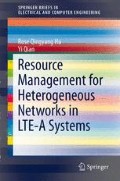Abstract
Global mobile traffic increases 66 times with an annual growth rate of 131 % between 2009 and 2014. On the contrary, the peak data rate from 3G to 4G wireless technology only increases 55 % annually. Clearly there is a huge gap between the capacity growth of new wireless access technologies and the growth of wireless data traffic demand. As wireless channel efficiency is approaching its fundamental limit, future improvements on the wireless capacity are more likely achieved by infrastructure technologies such as node density increase, cooperative and collaborative radio resource management techniques. Moreover, the fast growing data traffic volume and dramatic expansion of network infrastructures will inevitably trigger tremendous escalation of energy consumption in mobile wireless networks, the growing energy consumption becomes one of the major challenges in meeting the cost reduction and green environment targets. To meet those goals, heterogeneous network deployment has emerged as a new trend to enhance the capacity/coverage and to save energy consumption for the next generation wireless networks. A heterogeneous network, or HetNet, is a wireless network containing nodes with different transmission powers and coverage sizes. High power nodes with large coverage areas are deployed in a planned way for blanket coverage of urban, suburban, or rural areas. Low power nodes with small coverage areas aim to complement the high power nodes for coverage extension and throughput enhancement. Furthermore, the infrastructure featuring a high density deployment of low power nodes can also greatly improve energy efficiency compared to the one with a low density deployment of fewer high power nodes, owing to the high path loss exponent in a wireless environment.
Access this chapter
Tax calculation will be finalised at checkout
Purchases are for personal use only
Author information
Authors and Affiliations
Rights and permissions
Copyright information
© 2014 The Author(s)
About this chapter
Cite this chapter
Hu, R.Q., Qian, Y. (2014). Conclusion. In: Resource Management for Heterogeneous Networks in LTE Systems. SpringerBriefs in Electrical and Computer Engineering. Springer, New York, NY. https://doi.org/10.1007/978-1-4939-0372-6_6
Download citation
DOI: https://doi.org/10.1007/978-1-4939-0372-6_6
Published:
Publisher Name: Springer, New York, NY
Print ISBN: 978-1-4939-0371-9
Online ISBN: 978-1-4939-0372-6
eBook Packages: EngineeringEngineering (R0)

